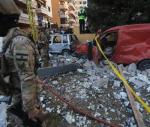You are here
Next onslaught on Gaza
Feb 09,2016 - Last updated at Feb 09,2016
It is not true that only three wars have taken place since Hamas won parliamentary elections in 2006 in the occupied Palestinian territories; other wars that were deemed insignificant or “skirmishes” also took place.
Operation Returning Echo in March 2012, for example, killed and wounded over 100 people. But since the death toll, relative to the other major onslaughts seemed trivial, it was not cited as war, per se.
According to this logic, Israeli operations Cast Lead (2008-9), Pillar of Defence (2012) and the deadliest of them all, Protective Edge (2014) were serious enough to be included in any relevant discussion, especially when a prospective new Israeli war on Gaza is considered.
It is important to note that most media, mainstream or other, adhere to Israel’s designation of war, not that of Palestinians.
For example, Gazans refer to their last confrontation with Israel as “Al Furqan Battle”, a term we almost never hear repeated with reference to the war.
Observing the Israeli war discourse as the central factor in understanding the war against the resistance surpasses that of language into other areas.
The suffering in Gaza has never ceased, not since the last war, the previous one or the one before that. But only when Israel begins to mull over war as a real option do many of us return to Gaza to discuss the various violent possibilities that lie ahead.
The problem of neglecting Gaza until Israeli bombs begin to fall is part and parcel of Israeli collective thinking, government and society alike.
Gideon Levy, one of the very few sympathetic Israeli journalists in mainstream newspapers, wrote about this in a recent article in Haaretz.
“The addiction to fear and the eternal wallowing in terror in Israel suddenly reminded one of the existence of the neighbouring ghetto,” he wrote in reference to Gaza and the sounding of Israeli war drums.
“Only thus are we here reminded of Gaza. When it shoots, or at least digs ... (only then) we recall its existence. Iran dropped off the agenda. Sweden isn’t scary enough. Hizbollah is busy. So we return to Gaza.”
Israel’s exceedingly violent past in Gaza does not hinge on Hamas’ relative control of the terribly poor and besieged place, nor is it related to Palestinian factionalism.
Certainly, Hamas’ strength there is hardly an incentive for Israel to leave Gaza alone, and Palestinians’ pitiful factionalism rarely helps the situation. However, Israel’s problem is with the very idea that there is a single Palestinian entity that dares challenge its dominance and dares to resist.
Moreover, the argument that armed resistance, in particular, infuriates Israel the most is also incorrect.
Violent resistance may speed up Israel’s retaliation and the intensity of its violence, but as we are currently witnessing in the West Bank, no form of resistance has ever been permissible, not now, not since the Palestinian Authority was essentially contracted to control the Palestinian population, and certainly not since the start of the Israeli military occupation in 1967.
Israel wants to have complete monopoly over violence, and that is the bottom line.
A quick scan of Israel’s history against Palestinian resistance in all its forms is indicative of the fact that the Israel vs Hamas narrative has always be reductionist, partly due to it being politically convenient for Israel, but also useful in the Palestinians’ infighting.
Fateh, which was Palestine’s largest political party until Hamas won 76 out of the legislative council’s 132 seats in the early 2006 elections, has played a major role in constructing that misleading narrative, one that sees the past wars and the current conflict as an exclusive fight between Hamas, a political rival, and Israel.
When seven Hamas fighters were recently killed after a tunnel collapsed — it was destroyed during the 2014 war by Israel but rebuilt — Fateh issued a statement that appeared on Facebook. It did not declare solidarity with the various resistance movements which have operated under horrendously painful circumstances and unremitting siege for years, but chastised the “war merchants” — in reference to Hamas — who, according to Fateh, “know nothing but burying their young people in ashes”.
But what other options does the resistance in Gaza actually have?
The unity government that was agreed on by Fateh and Hamas in the Beach Refugee Camp agreement in the summer of 2014 yielded no practical outcomes, leaving Gaza with no functioning government and a worsening siege.
That reality, for now, seals the fate of a political solution involving a unified Palestinian leadership.
Submitting to Israel is the worst possible option. If the resistance is Gaza was to lay down its arms, Israel would attempt to recreate the post-1982 Lebanon war scenario, when it pacified its enemies using extreme violence and then entrusted its collaborating allies to rearrange the subsequent political landscape.
While some Palestinians could readily offer to fill that disreputable role, the Gaza society is likely to shun it entirely.
A third scenario, in which Gaza is both free and the Palestinian people’s political wishes are respected, is also unlikely to materialise soon, considering the fact that Israel has no reason to submit to this option, at least for now.
This leaves the war option as the only real, tragic possibility.
Israeli analyst Amos Harel highlighted in his article “Hamas’ desire to increase West Bank attacks could trigger new Gaza war” the reasoning behind this logic.
“To date, Israel and Palestinian Authority security forces have succeeded in scuttling most of Hamas’ schemes,” he wrote, referring to his allegations that Hamas is attempting to co-opt the ongoing uprising in the West Bank.
He offered several scenarios: “the first is that a successful Hamas attack in the West Bank will spur an Israeli response against the group in Gaza, which will lead the parties into a confrontation”.
In most Israeli media analyses, there is almost total disregard for Palestinian motives, aside from some random inclination to commit acts of “terror”.
Of course, reality is rarely close to Israel’s self-centred version of events, as rightly pointed out by Levy.
After his most recent visit to Gaza, Robert Piper, UN envoy and humanitarian coordinator for the occupied territories, left the strip with a grim assessment: only 859 of the houses destroyed in the last war have been rebuilt.
He blamed the blockade for Gaza’s suffering, but also the lack of communication between the Ramallah-based government and the Hamas movement in Gaza.
“There’s no change to the underlying fragility of Gaza,” he told AFP, and the situation “remains on a frankly disastrous trajectory of de-development and radicalisation, as far as I can tell.”
Of the blockade, he said: “It is a blockade that prevents students from getting to universities to further their studies in other places. It’s a blockade that prevents sick people from getting the health care that they need.”
Under these circumstances, it is difficult to believe that another war is not looming.
Israel’s strategic, political and military tactics, as it stands today, will not allow Gaza to live with a minimal degree of dignity.
On the other hand, the history of Gaza’s resistance makes it impossible to imagine a scenario in which the strip raises a white flag and awaits its allotted punishment.
The writer, www.ramzybaroud.net, has been writing about the Middle East for over 20 years. He is an internationally syndicated columnist, a media consultant, author of several books and the founder of PalestineChronicle.com. His books include “Searching Jenin”, “The Second Palestinian Intifada” and “My Father Was a Freedom Fighter: Gaza’s Untold Story”. He contributed this article to The Jordan Times.













